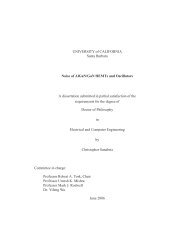Sine Wave Generation Techniques
Sine Wave Generation Techniques
Sine Wave Generation Techniques
Create successful ePaper yourself
Turn your PDF publications into a flip-book with our unique Google optimized e-Paper software.
<strong>Sine</strong>-<strong>Wave</strong>-<strong>Generation</strong> <strong>Techniques</strong><br />
Type<br />
Typical<br />
Frequency<br />
Range<br />
Typical<br />
Distortion<br />
(%)<br />
Typical<br />
Amplitude<br />
Stability<br />
(%)<br />
Comments<br />
Phase Shift 10 Hz–1 MHz 1–3 3 (Tighter Simple� inexpensive technique� Easily amplitude servo<br />
with Servo controlled� Resistively tunable over 2�1 range with<br />
Control) little trouble� Good choice for cost-sensitive� moderateperformance<br />
applications� Quick starting and settling�<br />
Wein Bridge 1 Hz–1 MHz 0�01 1 Extremely low distortion� Excellent for high-grade<br />
instrumentation and audio applications� Relatively<br />
difficult to tune�requires dual variable resistor with<br />
good tracking� Take considerable time to settle after<br />
a step change in frequency or amplitude�<br />
LC 1 kHz–10 MHz 1–3 3 Difficult to tune over wide ranges� Higher Q than RC<br />
Negative types� Quick starting and easy to operate in high<br />
Resistance frequency ranges�<br />
Tuning Fork 60 Hz–3 kHz 0�25 0�01 Frequency-stable over wide ranges of temperature and<br />
supply voltage� Relatively unaffected by severe shock<br />
or vibration� Basically untunable�<br />
Crystal 30 kHz–200 MHz 0�1 1 Highest frequency stability� Only slight (ppm) tuning<br />
possible� Fragile�<br />
Triangle- k 1 Hz–500 kHz 1–2 1 Wide tuning range possible with quick settling to new<br />
Driven Break-<br />
Point Shaper<br />
frequency or amplitude�<br />
Triangle- k 1 Hz–500 kHz 0�3 0�25 Wide tuning range possible with quick settling to new<br />
Driven frequency or amplitude� Triangle and square wave also<br />
Logarithmic available� Excellent choice for general-purpose<br />
Shaper requirements needing frequency-sweep capability with<br />
low-distortion output�<br />
DAC-Driven k1 Hz–500 kHz 0�3 0�25 Similar to above but DAC-generated triangle wave<br />
Logarithmic generally easier to amplitude-stabilize or vary� Also�<br />
Shaper DAC can be addressed by counters synchronized to a<br />
master system clock�<br />
ROM-Driven 1 Hz–20 MHz 0�1 0�01 Powerful digital technique that yields fast amplitude<br />
DAC and frequency slewing with little dynamic error� Chief<br />
detriments are requirements for high-speed clock (e�g��<br />
8-bit DAC requires a clock that is 256 c output sine<br />
wave frequency) and DAC glitching and settling� which<br />
will introduce significant distortion as output<br />
frequency increases�<br />
LOW DISTORTION OSCILLATION<br />
In many applications the distortion levels of a phase shift<br />
oscillator are unacceptable� Very low distortion levels are<br />
provided by Wein bridge techniques� In a Wein bridge stable<br />
oscillation can only occur if the loop gain is maintained at<br />
unity at the oscillation frequency� In Figure 2a this is<br />
achieved by using the positive temperature coefficient of a<br />
small lamp to regulate gain as the output attempts to vary�<br />
This is a classic technique and has been used by numerous<br />
circuit designers� to achieve low distortion� The smooth lim-<br />
iting action of the positive temperature coefficient bulb in<br />
combination with the near ideal characteristics of the Wein<br />
network allow very high performance� The photo of Figure 3<br />
shows the output of the circuit of Figure 2a� The upper trace<br />
is the oscillator output� The middle trace is the downward<br />
slope of the waveform shown greatly expanded� The slight<br />
aberration is due to crossover distortion in the FET-input<br />
LF155� This crossover distortion is almost totally responsible<br />
for the sum of the measured 0�01% distortion in this<br />
�Including William Hewlett and David Packard who built a few of these type circuits in a Palo Alto garage about forty years ago�<br />
2









